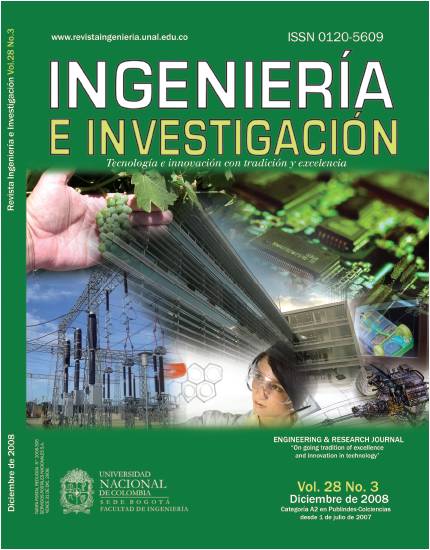Comparing two spatio-temporal query languages: SQLST and Güting’s language
Una comparación de dos lenguajes de consulta espacio temporales: SQLST y el de Güting
DOI:
https://doi.org/10.15446/ing.investig.v28n3.15133Keywords:
spatio-temporal database, spatio-temporal query language, SQL, comparison criteria (en)bases de datos espacio-temporales, lenguajes de consulta espacio-temporales, SQL, criterios de comparación (es)
Downloads
Spatio-temporal databases allow us to represent objects and phenomena from the real world which change position or shape as time elapses. Several query languages have been proposed during the last decade to deal with this type of database. Two of these languages have been compared in this paper: SQLST and Güting’s language. The comparison was based on criteria which have been applied to programming languages; however, they were adapted here to evaluate database query languages. The results led to concluding that both languages high degree of expressiveness may affect other criteria such as readability and simplicity, especially in the case of Güting’s language.
Las bases de datos espacio-temporales permiten representar objetos y fenómenos del mundo real que cambian de posición o forma a medida que transcurre el tiempo. En la última década se han propuesto diversos lenguajes de consulta para dicho tipo de bases de datos. En este artículo se comparan dos de estos lenguajes: SQLST y el de Güting. La comparación se realiza por medio de criterios que se han aplicado a lenguajes de programación, pero que se han adaptado para evaluar lenguajes de consulta de bases de datos. Los resultados permiten concluir que el alto grado de expresividad evidenciado por ambos lenguajes puede afectar otros criterios, como la legibilidad y la simplicidad, especialmente en el caso del lenguaje de Güting.
References
Bonifati, A., Ceri, S., Comparative Analysis of Five XML Query Languages., SIGMOD Record, Vol. 29, No.1, 2000, pp. 68-79. DOI: https://doi.org/10.1145/344788.344822
Chen, C., Zaniolo, C., Universal Temporal Extensions for Database Languages., 15th International Conference on Data Engineering, IEEE Computer Society Press, May, 1999, pp. 428-437.
Chen, C., Zaniolo, C., SQLST: A Spatio-Temporal Data Model and Query Language., Conceptual Modeling - ER 2000, 19th International Conference on Conceptual Modeling., October, 2000, pp. 96-111. DOI: https://doi.org/10.1007/3-540-45393-8_8
Chomicki, J., Revesz, P. Z., A Geometric Framework for Specifying Spatiotemporal Objects, 6th International Workshop on Temporal Representation and Reasoning., Orlando, IEEE Computer Society, May, 1999, pp. 41-46.
Darwen, H., Comunicación privada, Diciembre, 2007.
Date, C. J., An Introduction to Database Systems., 8a ed., Nueva York, Addison-Wesley, 2003.
Eisemberg, A., Melton, J., Kulkarni, K. G., Michels, J. E., Zemke, F., SQL: 2003., SIGMOD Record., Vol. 33, No. 1, 2004, pp. 119-126. DOI: https://doi.org/10.1145/974121.974142
Erwig, M., Schneider, M., STQL: A Spatio-Temporal Query Language., En: Mining Spatio-Temporal Information Systems (eds. R. Ladner, K. Shaw, M. Abdelguerfi), Kluwer Academic Publishers, 2002, pp. 105-126. DOI: https://doi.org/10.1007/978-1-4615-1149-6_6
Flon, L., On Research in Structured Programming., ACM SIGPLAN Notices, Vol. 10, No. 10, 1975, pp. 16-17. DOI: https://doi.org/10.1145/987253.987256
Gilman, L., Rose, A. J., APL: An Interactive Approach., 3a ed., Washington, Wiley, 1984.
Güting, R. H., Böhlen, M. H., Erwig, M., Jensen, C. S., Lorentzos, N. A., Schneider, M., Varzirgiannis, M., A Foundation for Representing and Querying Moving Objects., ACM Transactions on Databases Systems, Vol. 25, No. 1, 2000, pp. 1-42. DOI: https://doi.org/10.1145/352958.352963
Güting, R. H., Schneider, M., Moving Objects Databases., Oxford, Morgan Kaufmann, 2005.
Haase., P., Broekstra, J., Eberhart, A., Volz, R., A Comparison of RDF Query Languages., The Semantic Web – ISWC, 3rd International Semantic Web Conference, November, 2004, pp. 502-517. DOI: https://doi.org/10.1007/978-3-540-30475-3_35
Korth, H. F., Silberschatz, A., Sudarshan, S., Database Systems Concepts., 5a ed., Nueva York, McGraw-Hill, 2005.
McIver, L., Conway, D., Seven Deadly Sins of Introductory Programming Language Design., SEEP '96, International Conference on Software Engineering: Education and Practice, January, 1996, pp. 1-8.
Mendelzon, A., Vaisman, A. Temporal Queries in OLAP., 26th International Conference on Very Large Data Bases, Morgan Kaufmann, September, 2000, pp. 242-253.
Sebesta, R. W., Concepts of Programming Languages., 7a ed., Washington, Addison Wesley, 2007.
Turbak, F. A., Gifford, D. K., Design Concepts in Programming Languages., 1a ed., Boston, The MIT Press, 2008.
Wirth, N., On the Design of Programming Languages., Information Processing 74, North-Holland Publishing Co., 1974, pp. 386- 393.
Worboys, M. F., A Unified Model for Spatial and Temporal Information., The Computer Journal, Vol. 37, No.1, 1994, pp. 26-34. DOI: https://doi.org/10.1093/comjnl/37.1.26
How to Cite
APA
ACM
ACS
ABNT
Chicago
Harvard
IEEE
MLA
Turabian
Vancouver
Download Citation
License
Copyright (c) 2008 Luis Miguel Pérez Montoya, Francisco Javier Moreno Arboleda

This work is licensed under a Creative Commons Attribution 4.0 International License.
The authors or holders of the copyright for each article hereby confer exclusive, limited and free authorization on the Universidad Nacional de Colombia's journal Ingeniería e Investigación concerning the aforementioned article which, once it has been evaluated and approved, will be submitted for publication, in line with the following items:
1. The version which has been corrected according to the evaluators' suggestions will be remitted and it will be made clear whether the aforementioned article is an unedited document regarding which the rights to be authorized are held and total responsibility will be assumed by the authors for the content of the work being submitted to Ingeniería e Investigación, the Universidad Nacional de Colombia and third-parties;
2. The authorization conferred on the journal will come into force from the date on which it is included in the respective volume and issue of Ingeniería e Investigación in the Open Journal Systems and on the journal's main page (https://revistas.unal.edu.co/index.php/ingeinv), as well as in different databases and indices in which the publication is indexed;
3. The authors authorize the Universidad Nacional de Colombia's journal Ingeniería e Investigación to publish the document in whatever required format (printed, digital, electronic or whatsoever known or yet to be discovered form) and authorize Ingeniería e Investigación to include the work in any indices and/or search engines deemed necessary for promoting its diffusion;
4. The authors accept that such authorization is given free of charge and they, therefore, waive any right to receive remuneration from the publication, distribution, public communication and any use whatsoever referred to in the terms of this authorization.



























